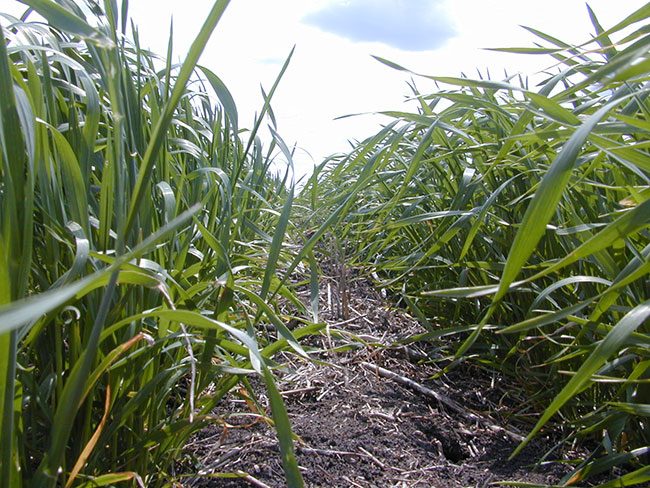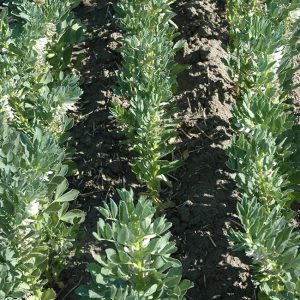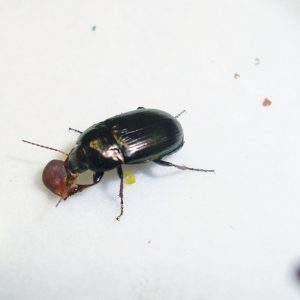
Features
Weeds
Attacking the weed seedbank
Turn loose the predators.
April 10, 2021 By Bruce Barker
 Maintaining cover encourages seed predators.
Maintaining cover encourages seed predators.
In the biocontrol world, most people think of beneficial insects as those that attack insect pests, such as the thirteen-spotted lady beetle consuming up to 160 aphids in 24 hours. But there are other beneficial insects out there at ground level quietly munching their way through the weed seedbank. These seed predators, such as ground beetles and crickets, can substantially reduce the amount of weed seed going into the seedbank.
“It’s very contextual as to how significant seed predation can impact the weed seedbank because there are so many different environmental interactions,” says Christian Willenborg, associate professor in the department of plant sciences at the University of Saskatchewan. “The predators can be there every year, but it is a very complicated network that depends on the types of weeds, the habitat, and the ground beetles that are present and attacking as seed predators.”
Typically in the weeds world, biocontrol is thought of as a specific insect targeting a specific weed. For example, Aphthona nigriscutis, or black dot beetle, has had a significant impact on leafy spurge populations.
Seed predation is different, and is a form of biocontrol that doesn’t target a particular plant. Rather, seed predators are generalists that eat many seeds that can contribute to the weed seedbank. In addition to ground beetles (Carabid beetles), mice, birds and earthworms can also feed on weed seeds. Some studies have found that rodents contribute to an equal or greater proportion of seed consumption than invertebrates.
In Europe, research has found that seed predators can consume large portions of weed seeds headed for the seedbank. At Wageningen University in the Netherlands, Westerman et al. found that “annual seed loss due to predation [number of seeds consumed per number of seeds produced per year] ranged from 32 to 70 per cent with continuous predator exposure from seed shed to harvest.” At the Research Institute of Crop Production, Prague, Czech Republic, Honek et al. found that “predation of seed on the ground in arable fields can be as high as 1,000 seeds per square metre per day by ground beetles.”
Closer to home, graduate student Sharavari Kulkarni with the Department of Agricultural, Food and Nutritional Science at the University of Alberta (U of A) spent several years studying the role of ground beetles in biological control of weeds. She conducted several studies under the supervision of Willenborg, John Spence in the Department of Renewable Resources at the U of A, and the late Lloyd Dosdall of the Department of Agriculture, Food and Nutritional Science at the U of A.
Kulkarni’s first study investigated the preferences of four adult carabids for volunteer canola, stinkweed and wild mustard. She essentially laid out a smorgasbord for the carabids, and let them eat as much as they wanted of what they wanted. All carabid species preferred volunteer canola seeds the most, followed by wild mustard seeds, and then stinkweed. Beetles highly preferred seeds of all three weeds that had taken up moisture (imbibed) compared to dry seed. The density of the carabids and how active they were accounted for 67 per cent of the observed variation in seed removal.
In subsequent research, Kulkarni set up a study to see if odours given off by seed translated into seed preferences of three carabid species for the same three weed species that were either dry or imbibed with water. The laboratory apparatus used was somewhat complex, but similar to lining up glasses of single malt scotch and having a sniff. Results of this test found that two of the three carabid species tested preferred water-imbibed volunteer canola seeds over other weed species. Additionally, this preference was only for imbibed seeds, because the three carabid species did not discriminate between weeds that were dry.
Encouraging seed predators
Willenborg says that farmers can use multiple strategies to try to encourage seed predation. It basically comes down to Maslow’s Hierarchy of Needs theory, where basic food, water and shelter are the primary needs. Anything that encourages biodiversity usually encourages seed predators.
Crop diversity is one factor that can help seed predators. Andrew Heggenstaller’s research at Ames, Iowa, found that percentage seed predation varied during the time of year and by crop. For example, seed predation in corn and soybean crops was highest during the summer, while predation in small grain and legume crops was low in the summer but high in the spring and fall. Seed predation in alfalfa fluctuated throughout the growing season.
Practices that encourage ‘shelter’ for seed predators can also improve survival and seed predation. Shelterbelts, grassed field edges, ditches, buffers and pollinator strips can provide overwinter habitat. Cover crops can also provide shelter with legumes filling the gaps between harvest and winter.
The move to no-till on the Prairies has benefited seed predators. Kulkarni also investigated the impact of seed burial on seed consumption. Seed burial depth influenced seed consumption rates with a significant interaction between seed burial depth, carabid species, and gender of the carabid species tested. She observed that higher seed consumption by females of all species occurred, and that there was greater consumption of seeds scattered on the soil surface compared with seeds buried at any depth. However, there was evidence of seed consumption at all depths and seed burial did not eliminate weed seed predation.
Even though seed predators may feed below the soil surface, they generally do not feed very deeply – often only one to two centimetres deep. Seeds on the soil surface are plainly more vulnerable to seed predation, but tillage can also impact the predators – Willenborg says it is “extremely detrimental to the survival of seed predators.”
Pesticide application can also be detrimental to seed predators. Many pesticides that will kill a pollinator will also likely to kill a ground beetle, Willenborg says.
Is encouraging seed predation worth it? Willenborg has found that in pulse crops, seed predation reached as high as 85 per cent of volunteer canola and 55 per cent of kochia weed seeds. At Boone, Iowa, research by van der Laat et al. found that maximum seed predation for common lambs-quarters was 53 per cent in 2003 and 64 per cent in 2004. Common waterhemp seed predation reached 80 per cent in 2003 and 85 per cent in 2004.
“The economic impact of seed predators might seem small in some cases, especially because we cannot directly observe their actions or results, but the predators are there and they’re working for free,” Willenborg says. “I am hard-pressed to think of any other type of free weed control growers can obtain within their cropping systems.”

